Vacheron Constantin’s history has been filled with extraordinary, complicated, and elegant timepieces.
In honor of the introduction of the world’s most complicated timepiece on September 17, 2015, let’s take a look at the five most complicated pocket watches the traditional Genevan “maison” has produced throughout its 260-year history.
Reference 57260
The top slot naturally goes to brand-new Reference 57260, which holds the title as the world’s most complicated timepiece. Boasting 2,601 individual components in the movement alone (the whole watch contains more than 2,800 parts), there is unlikely to be a watch that will come close to this level of complication for a very long while.
One element that sets Reference 57260 apart from every other Vacheron Constantin in existence is the use of diamond-coated silicon in the escapement (pallet lever and escape wheel). The master watchmakers needed to use it to keep the weight of the movement in general and the escapement in particular as low as possible.
For the full specs and story of Reference 57260’s creation, please see Vacheron Constantin’s Reference 57260 Is The Most Complicated Portable Watch In The World.
Complications
Fifty-seven complications aside from the regulator-style hours, minutes, and seconds including perpetual calendar with moon phases, leap year, zodiac sign, season, equinox and solstice and age of moon, Hebraic perpetual calendar including displays of the century, decade and Yom Kippur, astronomical calendar with celestial sky chart and sidereal indications, grande and petite sonnerie with silencer and night mode, alarm with choice of one or Westminster gong, power reserve displays for chime and movement, display of alarm torque and alarm power reserve, equation of time, display of sunrise/sunset calibrated to location of owner, double retrograde split-seconds chronograph, second time zone with day/night indication, world time, length of day, length of night, perpetual ISO calendar for display of calendar weeks
King Farouk I of Egypt
The timepiece with its gilt dial was made between 1930 and 1935 and presented to King Farouk I of Egypt by the Geneva authorities in 1946. It is Vacheron Constantin high watchmaking at its finest and is also the second most complicated pocket watch that the brand has created in its history.
Its extra-large 80 mm, 18-karat gold case contains a keyless winding clock-watch movement boasting a minute repeating grande et petite sonnerie, an astronomical perpetual calendar with moon phases, a split-seconds chronograph with a 30-minute instantaneous recorder, and an alarm. Thirteen hands are needed to display all the functions of this horological entity. Power reserve indicators for both the going and the striking trains are also integrated. With all this horological finesse, it is probably needless to say that the movement comprises 820 components.
King Farouk was legendarily enamored of the glamorous lifestyle that went along with belonging to a royal house and he visited Vacheron Constantin’s Geneva premises in 1937. Vacheron Constantin’s community manager Alexandre Ghotbi posted this anecdote regarding the visit on the Hour Lounge.
“Charles Constantin, acting as his guide on the tour, confessed his surprise at the breadth of the young prince’s knowledge of watchmaking [Farouk was 17 at the time],” he relates. Farouk is reported to have said to Constantin, “But Monsieur Constantin, I dismantled so many watches when I was a child . . . unfortunately for them . . . !”
Farouk was overthrown in a coup launching the Egyptian Revolution in 1952 (and the watch was sold in 1954). It now belongs to a private collector.
Complications
Fifteen total complications including a carillon minute repeater, grande et petite sonnerie (three gongs), split-seconds chronograph, perpetual calendar with moon phase, alarm, two power reserve indications (one for the movement and one for the strike train)
King Fouad I of Egypt
King Fouad I was the owner of the third most complicated pocket watch in Vacheron Constantin’s extensive history. This timepiece, whose manufacture began in 1914, was presented to him in 1928 by the Swiss expatriate community. Like the timepiece his son, King Farouk, was to receive almost a decade later, it is a unique double-train clock-watch specimen housed in a large 18-karat yellow gold case with keyless winding.
King Fouad’s watch, however, is decorated with a beautiful, artistic enamel rendering of the flag of Egypt and Sudan on the outside case back. The inside case back is embellished with an engraved inscription to King Fouad in French, which reads, “A sa Majesté Fouad 1er, Hommage de la Colonie Suisse d’Egypte, 1929” (“to his majesty Fouad I in tribute from the Swiss community in Egypt”).
A striking clock-watch, the movement powered by two spring barrels – one each for the movement and the strike train and both wound by the crown – contains an astronomical perpetual calendar with phases and age of the moon, which is accompanied by a carillon minute-repeating grande et petite sonnerie with silence function as well as a 30-minute split-seconds chronograph.
Boasting a total of eleven hands to display the functions of the movement’s 657 components, this complicated timepiece also includes an alarm, which, according to an Antiquorum catalogue that displayed it for sale in 2003, is a function rarely found in complicated watches.
Vacheron Constantin made two of these, each unique and with slightly different complications. Ghotbi explained in an Hour Lounge posting, “To our knowledge, during the end of the nineteenth century and the first quarter of the twentieth century, Vacheron Constantin made only four other watches with alarms (References 346669, 348872, 365821, and 408270) in addition to these two ultra-complicated watches for King Fouad and King Farouk. These are either simple alarm watches or in combination with a chronograph.”
Ghotbi went on to explain that in addition to the complications, Vacheron Constantin paid special attention to the timekeeping qualities of this timekeeper: boasting a superb high finish, it also features a special and very rarely seen regulating organ with gold and platinum screws on the balance wheel and a Guillaume balance. “Complicated watches with Guillaume balances are extremely rare; we have seen only a few,” he explains in the same post.
The solid silver dial is notable in particular because of the calendar’s digital weekday display in a window in the 12 o’clock position.
When the King Fouad appeared at an Antiquorum auction in 2005, it sold for more than 3.3 million Swiss francs. It now belongs to Vacheron Constantin.
Complications
Thirteen total complications including carillon minute repeater, grande et petite sonnerie (three gongs), split-seconds chronograph, perpetual calendar with ages and phases of the moon
Count Guy de Boisrouvray
This is the fourth most complicated pocket watch by Vacheron Constantin. It was sold in 1948 to Count Guy de Boisrouvray, a cousin of Monaco’s Prince Rainier III, a collector of both art and jewels thanks to having married well. His wife, Luz Mila Patiño, had inherited a fortune from Bolivian tin magnate Simón Patiño, one of the richest men in the world at the time.
The complicated movement was outfitted with a split-seconds chronograph, a perpetual calendar with moon phases, a carillon minute repeater, and an alarm function with an extra hand for setting the alarm (a rarity in pocket watches at that time).
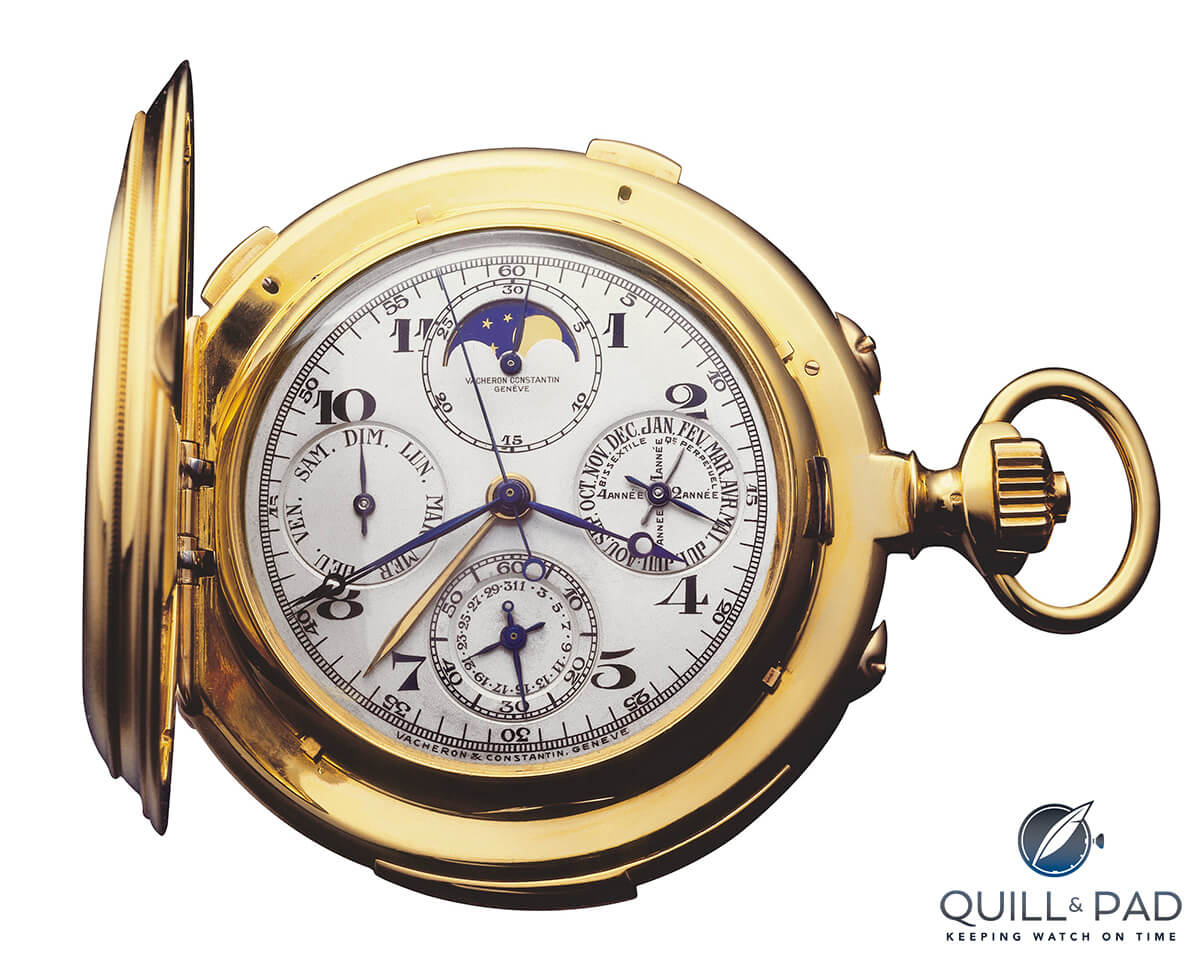
The fourth most complicated pocket watch in Vacheron Constantin’s history is known as the Count Guy De Boisrouvray
Perhaps even more exciting, though, is its Guillaume balance using gold and platinum adjustment screws, whose properties made it especially resistant to changes in temperature and magnetic fields. It also boasts a special regulation system for precision setting.
This royal timepiece is now at home in a private collection.
Complications
Ten complications in total including carillon minute repeater (three gongs), split-seconds chronograph, alarm, perpetual calendar with moon phases
James Ward Packard
American inventor and founder of the Packard Motor Company, James Ward Packard began his illustrious horological collecting tick with masters such as Dent, Victor Kullberg (chronometer maker to king of Sweden), Guex, and Chevalier before moving on to Jules Jürgensen, Agassiz (later to become Longines), Waltham, and, of course, Vacheron Constantin.
This pocket watch outfitted with a double gear train and encased in decoratively engraved 20-karat gold represents the peak of his now-legendary collection. He took possession of the watch bearing his initials in blue champlevé enamel in 1919. Its crystal is unusually crafted from rock crystal, a very difficult material to work with even today.
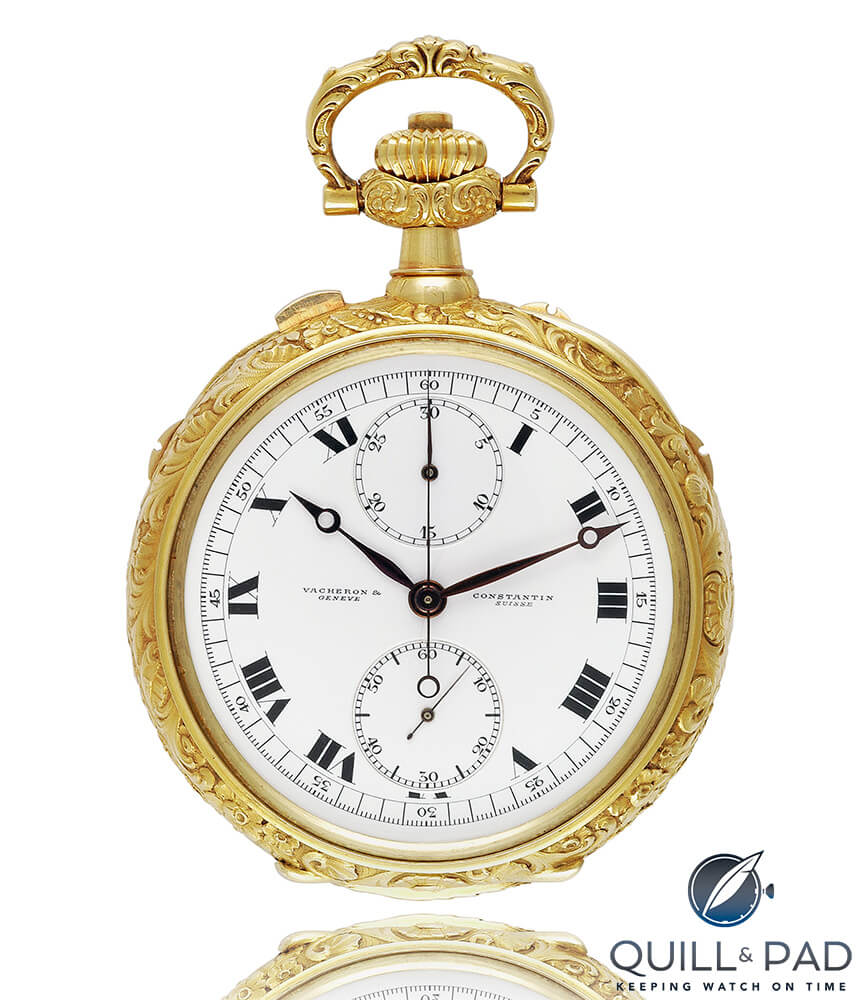
The fifth most complicated pocket watch in Vacheron Constantin’s history is a decorative 7 1/2 minute repeater housed in 20-karat gold made for James Ward Packard
Typical of Vacheron Constantin’s style of understated luxury, and in somewhat of a contrast to the decorative case, the enamel dial was designed for clear legibility.
This is the only known watch to contain a large and small sonnerie combined with a chronograph and a quarter and half-quarter (seven and a half minutes) repeater. A Guillaume balance also swings within this watch’s regulating system for added precision.
This watch appeared at auction in New York in June 2011, where it sold for almost $1.8 million. It now belongs to Vacheron Constantin.
Complications
Six total complications including quarter and half-quarter repeater, grande et petite sonnerie, monopusher chronograph
Trackbacks & Pingbacks
-
[…] It also provides interesting information on the legendary pocket watches owned by James Ward Packard and Egyptian kings Fouad and Farouk – which you can also learn about in Give Me Five! Vacheron Constantin’s Five Most Complicated Pocket Watches Ever. […]
Leave a Reply
Want to join the discussion?Feel free to contribute!





















































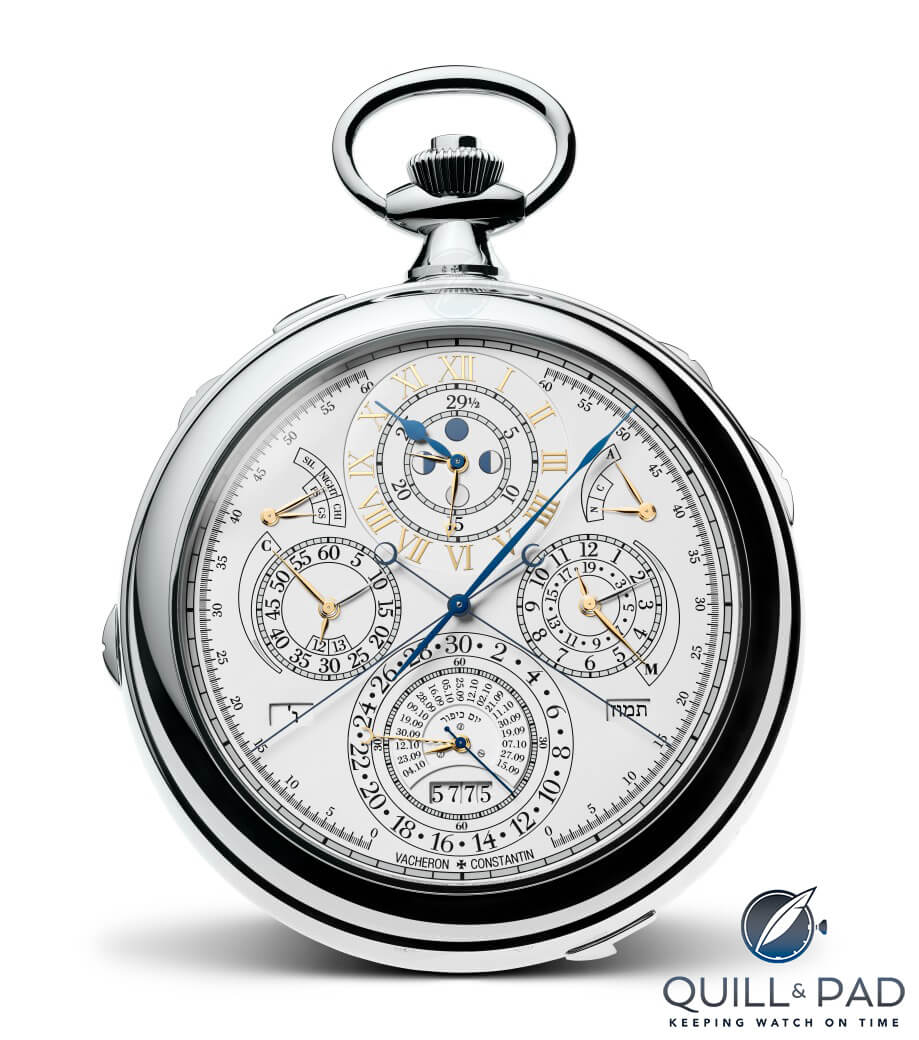
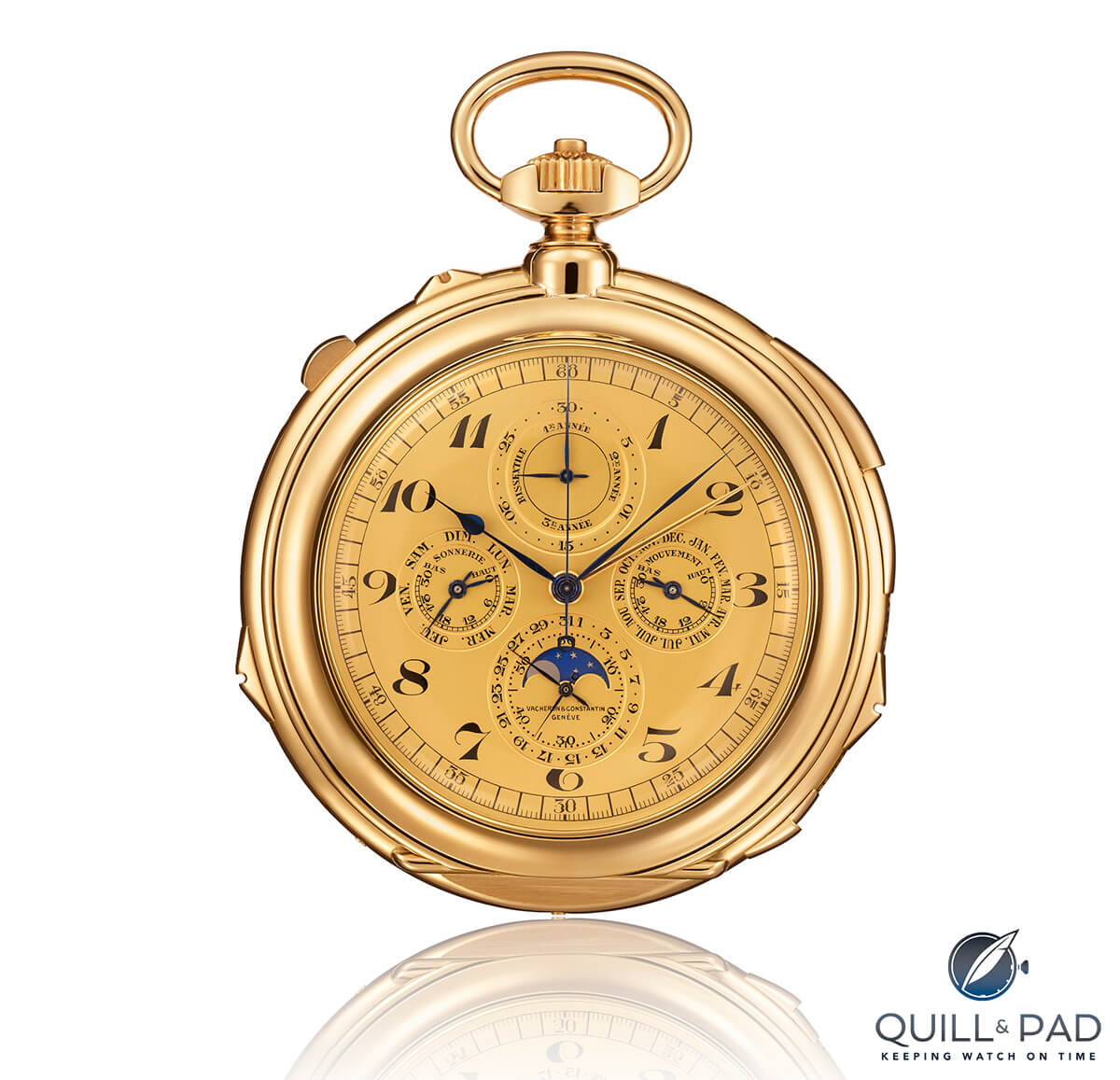
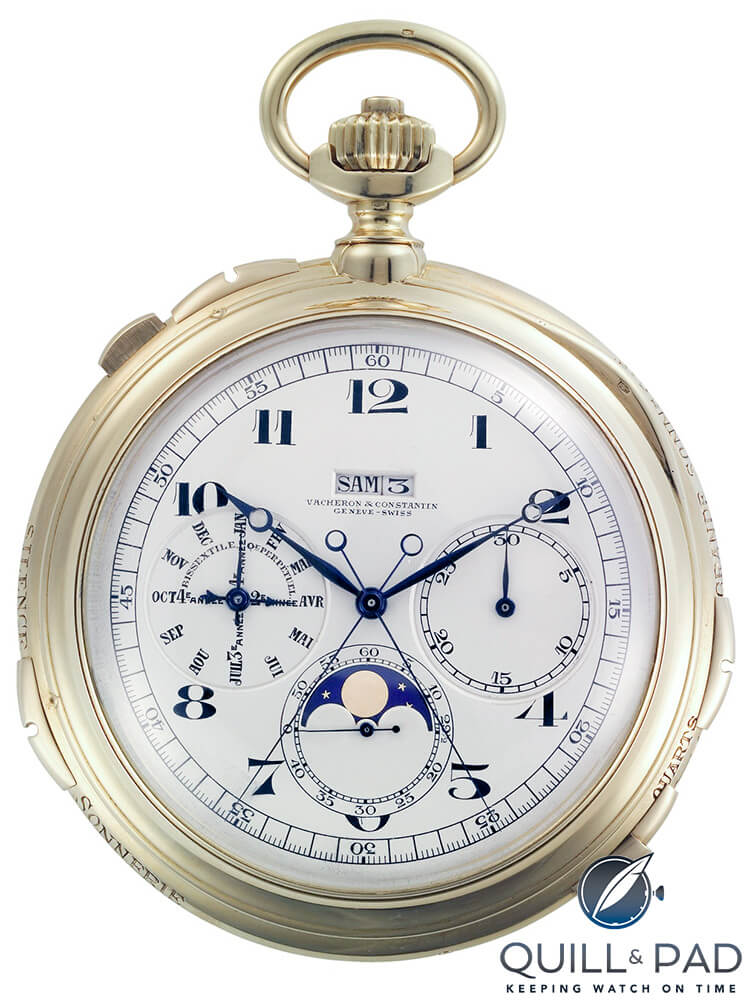
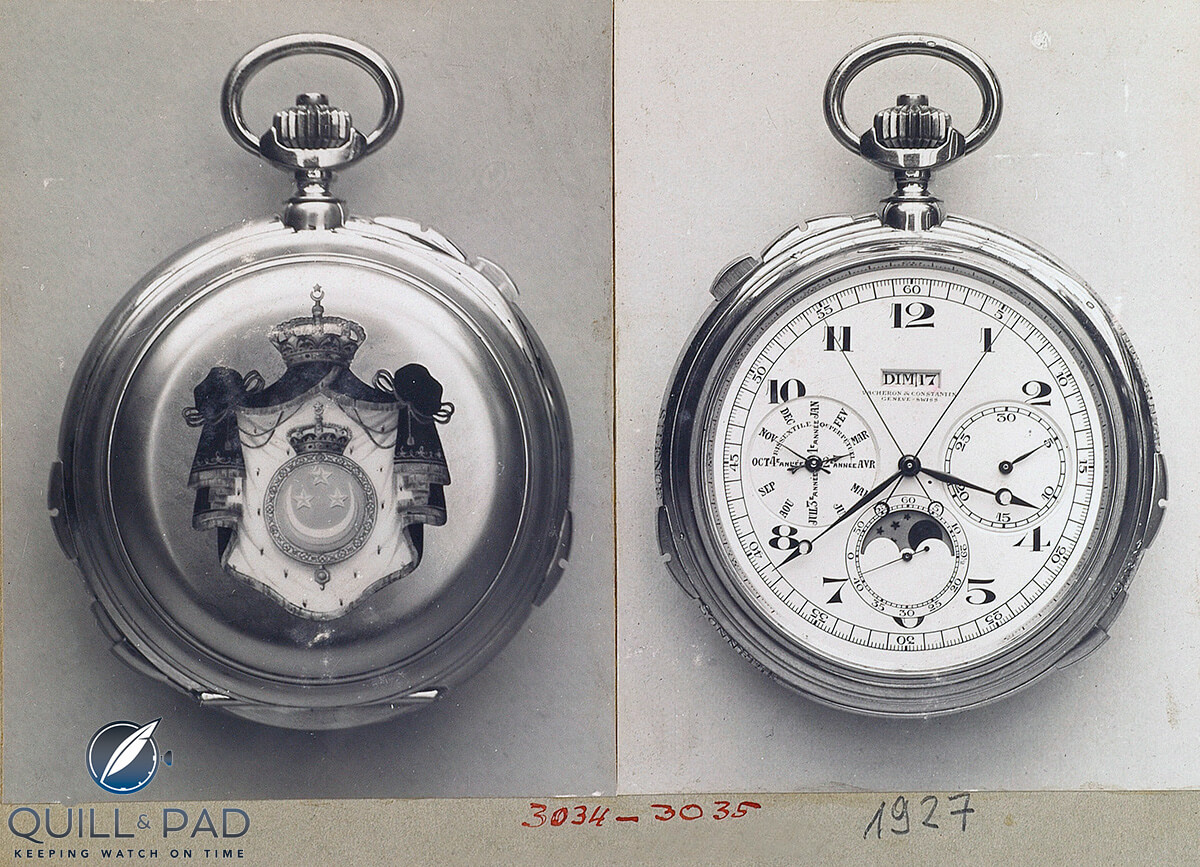
Stunning pieces! Would watchmakers outside of VC be able to service them?
Hi Tim, yes, definitely. A watchmaker specialized in restoration and/or vintage timepieces would definitely be able to service and maintain these.